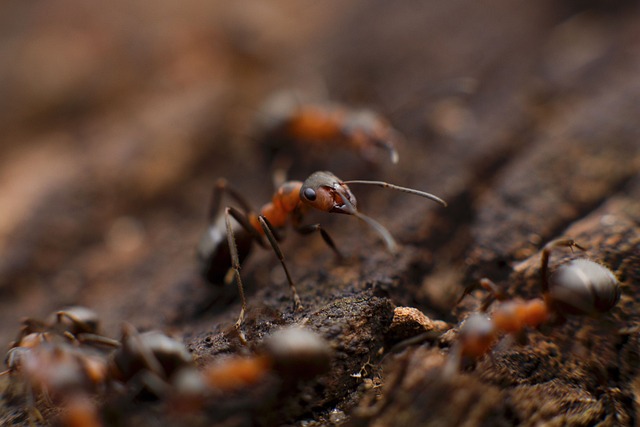Integrated Pest Management (IPM) provides an eco-friendly alternative to traditional chemical professional ant extermination. By focusing on prevention, least-toxic methods like biological controls and targeted non-toxic pesticides, IPM ensures sustainable ant control. This holistic approach, which includes thorough inspection, cultural practices, and mechanical methods, minimizes chemical use and disrupts the ant life cycle, promoting long-term prevention of infestations in both residential and commercial settings.
Ants can quickly turn into a persistent pest, leading many to seek professional ant extermination services. However, traditional methods often rely on harsh chemicals with potential environmental and health impacts. Integrated Pest Management (IPM), a sustainable approach, offers a more eco-friendly solution. This article explores IPM for ants, highlighting its benefits over conventional methods. We’ll break down the key components of an effective IPM strategy and provide insights into how it can be implemented to achieve long-term ant control without compromising sustainability.
Understanding Integrated Pest Management (IPM) for Ants
Integrated Pest Management (IPM) is a holistic approach to pest control that focuses on preventing and minimizing infestations rather than solely relying on chemical pesticides. When it comes to ant control, IPM strategies involve a combination of methods to effectively manage these persistent pests. The first step in professional ant extermination within the IPM framework is identifying the specific ant species causing the problem, as different ants require tailored solutions.
This approach prioritizes the use of least-toxic methods, such as biological controls (introducing natural predators), physical barriers, and targeted applications of non-toxic or low-toxicity pesticides when necessary. By integrating multiple tactics, IPM ensures a more sustainable and environmentally friendly ant control strategy compared to traditional, chemical-heavy methods. It also promotes the long-term prevention of ant infestations in homes and commercial spaces.
Professional Ant Extermination: Traditional Methods vs. IPM
Professional ant extermination is a critical aspect of maintaining a pest-free environment, but traditional methods often come with drawbacks. The conventional approach typically involves heavy use of chemical pesticides, which can have severe environmental and health impacts. These chemicals may also lead to resistance in ant populations over time, rendering them less effective.
Integrated Pest Management (IPM), on the other hand, offers a more sustainable and holistic solution. IPM emphasizes the use of least-toxic methods, such as biological controls, trap crops, and cultural practices. By implementing these strategies, professionals can effectively manage ant infestations while minimizing the negative effects on non-target organisms, the environment, and human health.
Key Components of an Effective IPM Strategy for Ant Control
An effective Integrated Pest Management (IPM) strategy for ant control involves several key components that combine to create a sustainable and environmentally friendly approach. First, thorough inspection and identification are crucial. Professionals must carefully assess areas of concern, pinpointing ant entry points, nesting sites, and active trails. This step is vital as it enables targeted treatments, minimizing the use of chemicals in unnecessary areas.
Once identified, IPM employs a variety of methods including biological control, where natural predators or parasites are introduced to manage ant populations. Cultural practices such as proper sanitation, sealing entry points, and maintaining a clean environment also play a significant role. Additionally, mechanical methods like baiting stations and traps can be used for more targeted applications. These integrated tactics work together to disrupt the ant life cycle, deter infestations, and offer effective professional ant extermination without harmful residuals.
Benefits and Implementation of Sustainable Ant Control Using IPM Solutions
Integrated Pest Management (IPM) offers a sustainable and eco-friendly approach to ant control, transforming the traditional methods of professional ant extermination. By focusing on prevention, monitoring, and targeted treatments, IPM minimizes the reliance on chemical pesticides, which can have harmful effects on both the environment and non-target organisms. This holistic strategy involves identifying and eliminating ant sources, improving sanitation practices, and using biological controls such as beneficial insects or plant extracts to manage infestations naturally.
Implementing IPM for ant control requires a comprehensive strategy tailored to specific environments. It starts with regular inspections to identify ant activities and potential entry points. Trained professionals then use this data to deploy targeted tactics, such as baiting systems or mechanical exclusions, to disrupt ant trails and colonies without causing unnecessary harm. This method not only ensures effective ant management but also promotes a healthier, more balanced ecosystem within the treated areas.
Integrated Pest Management (IPM) offers a sustainable and environmentally friendly approach to ant control, surpassing the limitations of traditional methods. By focusing on prevention, monitoring, and targeted interventions, IPM strategies not only eliminate ant infestations but also protect ecosystems from harmful chemicals. Adopting professional ant extermination techniques aligned with IPM principles is key to creating healthier environments both indoors and outdoors, ensuring long-term solutions for ant control while preserving biodiversity.
